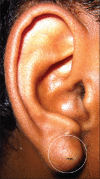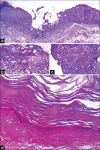Follicular Hybrid Cyst with Rare Juxtaposition of Epidermal Cyst and Steatocystoma
- PMID: 28932064
- PMCID: PMC5596647
- DOI: 10.4103/ijt.ijt_21_17
Follicular Hybrid Cyst with Rare Juxtaposition of Epidermal Cyst and Steatocystoma
Abstract
Any cutaneous cyst differentiating toward two or more pilosebaceous components is known as follicular hybrid cyst (FHC). A combination of epidermal and trichilemmal cyst is its most frequent example. Other combinations of pilosebaceous derivatives occur uncommonly as well. The histogenesis of this condition has been controversial. In this latest report, we describe an unusual FHC from the earlobe of a 19-year-old male, which expressed the cohabitation of epidermal cyst and steatocystoma. A sharp transition was noted between the two kinds of epithelial components.
Keywords: Earlobe; epidermal cyst; follicular hybrid cyst; pilosebaceous follicle; steatocystoma.
Conflict of interest statement
There are no conflicts of interest.
Figures


Similar articles
-
Follicular hybrid cysts. An expanded spectrum.Am J Dermatopathol. 1991 Jun;13(3):228-33. doi: 10.1097/00000372-199106000-00003. Am J Dermatopathol. 1991. PMID: 1714246 Review.
-
Follicular hybrid cysts with infundibular, isthmic-catagen, and pilomatrical differentiation: a report of 2 patients.Ann Diagn Pathol. 2006 Apr;10(2):110-3. doi: 10.1016/j.anndiagpath.2005.07.016. Ann Diagn Pathol. 2006. PMID: 16546048
-
Clinicopathological Appraisal of Cutaneous Cysts: A 2-Year Retrospective Observational Study.Indian Dermatol Online J. 2023 Oct 27;14(6):844-848. doi: 10.4103/idoj.idoj_239_23. eCollection 2023 Nov-Dec. Indian Dermatol Online J. 2023. PMID: 38099050 Free PMC article.
-
[Main Types of Cysts in Dermatopathology: Part 1].Rev Esp Patol. 2024 Jan-Mar;57(1):27-41. doi: 10.1016/j.patol.2023.11.006. Epub 2024 Jan 3. Rev Esp Patol. 2024. PMID: 38246707 Review. Spanish.
-
A Hybrid Skin Cyst at an Unusual Location: A Case Report.Cureus. 2024 Sep 1;16(9):e68378. doi: 10.7759/cureus.68378. eCollection 2024 Sep. Cureus. 2024. PMID: 39360082 Free PMC article.
References
-
- Weedon D. Cysts, sinuses and pits. In: Davie B, editor. Weedon's Skin Pathology. 3rd ed. London: Churchill Livingstone, Elsevier; 2010. pp. 442–57.
-
- Lee KY, Kwon YS, Roh MR, Chung KY. A case of a follicular hybrid cyst. Ann Dermatol. 2007;19:153–6.
-
- McGavran MH, Binnington B. Keratinous cysts of the skin. Identification and differentiation of pilar cysts from epidermal cysts. Arch Dermatol. 1966;94:499–508. - PubMed
-
- Kim MS, Lee JH, Son SJ. Hybrid cysts: A clinicopathological study of seven cases. Australas J Dermatol. 2012;53:49–51. - PubMed
Publication types
LinkOut - more resources
Full Text Sources
Other Literature Sources

